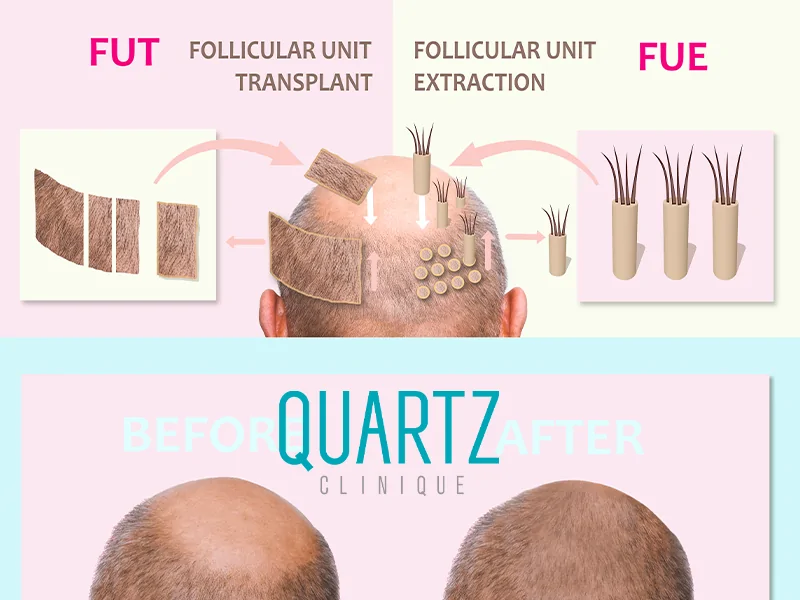What is Follicular Unit Transplant (FUT) Technique ?
FUT Hair Transplant is a hair transplant technique in which hair follicles are harvested from the donor area (usually the back of the head) and transplanted to the recipient area (usually the front, top, or crown of the head). The follicular units are naturally occurring groupings of one to four hair follicles, and the technique involves removing a strip of skin from the donor area and dissecting it into individual follicular units. The follicular units are then transplanted to the recipient area, where they take root and grow new hair.
FUT is typically performed by a dermatologist or plastic surgeon in a medical setting. The procedure can take several hours to several days, depending on the size of the transplant. It is generally considered to be a safe and effective treatment for hair loss, although it can be associated with some risks and side effects, such as scarring, infection, and pain. Some people may also experience temporary swelling, redness, or itching after the procedure.
Overall,
FUT is a popular choice for hair transplantation because it can produce natural-looking results and is relatively straightforward to perform. However, there are alternative hair transplant techniques, such as follicular unit extraction (FUE), that may be more suitable for some people depending on their specific needs and goals.
How FUT Hair Transplant Works ?
FUT Hair Transplant involves several steps:
-
- Consultation: The first step is to consult with a dermatologist or plastic surgeon who specializes in hair transplantation. The doctor will evaluate your hair loss, determine the cause, and discuss your goals and expectations for the procedure.
-
- Preparation: Before the procedure, the doctor will give you instructions on how to prepare, such as avoiding certain medications and stopping smoking. You may also be given a prescription for pain medication.
-
- Anesthesia: The procedure is typically performed under local anesthesia, which numbs the area where the hair will be transplanted. You may also be given a sedative to help you relax.
-
- Harvesting: The next step is to harvest the donor hair from the back of the head. The doctor will remove a strip of skin from the donor area and then dissect it into individual follicular units using a microscope.
-
- Graft preparation: The follicular units are then prepared for transplantation by placing them into a solution that helps to keep them viable.
-
- Transplantation: The follicular units are transplanted to the recipient area, where they are carefully placed in small incisions made by the doctor.
-
- Recovery: After the procedure, the transplanted hair will fall out, but new hair should start to grow within a few months. You will need to follow the doctor’s instructions for caring for the transplanted area and avoiding activities that could cause trauma to the hair.
Overall, the goal of FUT is to transplant healthy hair follicles from the donor area to the recipient area, where they will take root and grow new hair. The procedure can be time-consuming, but it is generally considered to be safe and effective for treating hair loss.
How Long Does FUT Hair Transplant Operation Last?
The duration of a
FUT Hair Transplant procedure can vary depending on the size of the transplant and the specific technique being used. In general,
FUT procedures can take several hours to several days to complete.
The time required for the procedure may be influenced by factors such as the number of follicular units being transplanted, the complexity of the case, and the surgeon’s level of experience. For example, a small FUT procedure involving only a few hundred follicular units may take only a few hours to complete, while a larger procedure involving several thousand follicular units may take several days to complete.
It is important to note that FUT is a surgical procedure that requires careful planning and execution. The surgeon will need to carefully harvest the follicular units from the donor area, prepare them for transplantation, and then carefully place them in the recipient area. This process requires a high level of skill and attention to detail, and it is important that the surgeon takes the necessary time to ensure that the procedure is performed safely and effectively.
What Is The Success Rate Of FUT Hair Transplant?
The success rate of
FUT Hair Transplant is generally high, with most people experiencing good to excellent results. However, the success of the procedure can depend on several factors, including the cause of the hair loss, the quality of the donor hair, and the skill of the surgeon.
In general,
FUT is considered to be a safe and effective treatment for hair loss, and the majority of people who undergo the procedure experience good results. However, it is important to be aware that the outcome of the procedure may not be the same for everyone, and some people may experience less than optimal results.
Some factors that may influence the success of
FUT include:
-
- The cause of the hair loss: FUT is most effective for treating male pattern baldness, which is caused by a genetic sensitivity to the hormone dihydrotestosterone (DHT). If the cause of the hair loss is something other than DHT, the success of the procedure may be less predictable.
-
- The quality of the donor hair: The success of FUT depends on the availability of healthy hair follicles in the donor area. If the donor hair is thin or weak, the transplanted hair may not be as robust as it would be with healthy donor hair.
-
- The skill of the surgeon: The success of FUT also depends on the skill and experience of the surgeon. It is important to choose a qualified and experienced hair transplant specialist to maximize the chances of a successful outcome.
It is important to discuss your goals and expectations for the procedure with your surgeon and to understand that the results may not be the same for everyone.
FUT vs. FUE hair transplant
FUT Hair Transplant and
follicular unit extraction (FUE) are two techniques that are used for hair transplantation. Both techniques involve removing hair follicles from a donor area (usually the back of the head) and transplanting them to a recipient area (usually the front, top, or crown of the head).
The main difference between
FUT and FUE is the way in which the hair follicles are harvested. In FUT, a strip of skin is removed from the donor area and dissected into individual follicular units using a microscope. In
FUE, individual hair follicles are extracted directly from the scalp using a specialized punch tool.
Some key differences between FUT and FUE include:
-
- Scarring: FUT involves removing a strip of skin from the donor area, which can result in a linear scar. FUE does not leave a linear scar, but it can result in small, circular scars at the site of each hair follicle extraction.
-
- Recovery time: FUT typically requires a longer recovery time than FUE, as the strip of skin that is removed must heal.
-
- Pain: FUT is typically associated with more pain and discomfort than FUE, as it involves a larger incision.
-
- Graft survival: Some studies have suggested that the survival rate of grafts (transplanted hair follicles) may be slightly higher with FUT than with FUE.
Ultimately, the choice between FUT and FUE will depend on the individual’s specific needs and goals, as well as the advice of a qualified hair transplant specialist. Both techniques can produce good results, but FUE may be a better choice for some people due to the reduced scarring and recovery time.
FUT Hair Transplant Side Effects
Follicular unit transplant (FUT) As with any surgical procedure, FUT carries certain risks and potential side effects.
Some potential side effects of
FUT include:
-
- Scarring: FUT involves removing a strip of skin from the donor area, which can result in a linear scar. The scar may be noticeable, especially if the hair in the donor area is short.
-
- Infection: There is a risk of infection at the site of the incision or at the transplanted hair follicles.
-
- Pain: FUT can be associated with pain and discomfort, especially in the days immediately following the procedure. Pain medication may be prescribed to manage discomfort.
-
- Swelling: Swelling is common after FUT and may last for several days.
-
- Redness: The transplanted area may be red and inflamed for a few days after the procedure.
-
- Itching: Itching is a common side effect of FUT and may persist for several weeks after the procedure.
To minimize the risk of complications, it is important to follow the instructions provided by the surgeon, including instructions for caring for the transplanted area and avoiding activities that could cause trauma to the hair. It is also important to seek medical attention if any unusual symptoms or complications arise.
What is the FUT Hair Transplant Price?
The price of follicular unit transplant (FUT) surgery varies depending on the patient’s current hair condition, the amount of transplant needed, the number of sessions required, the doctor’s experience, and the quality of the clinic. In addition, it is not legal for Health Ministry-approved centers to specify prices on their websites. Therefore, patients who are struggling with hair loss due to genetic factors and want to find a solution to this problem at an early stage can call our clinic at 02122414624 for detailed information and an appointment.



